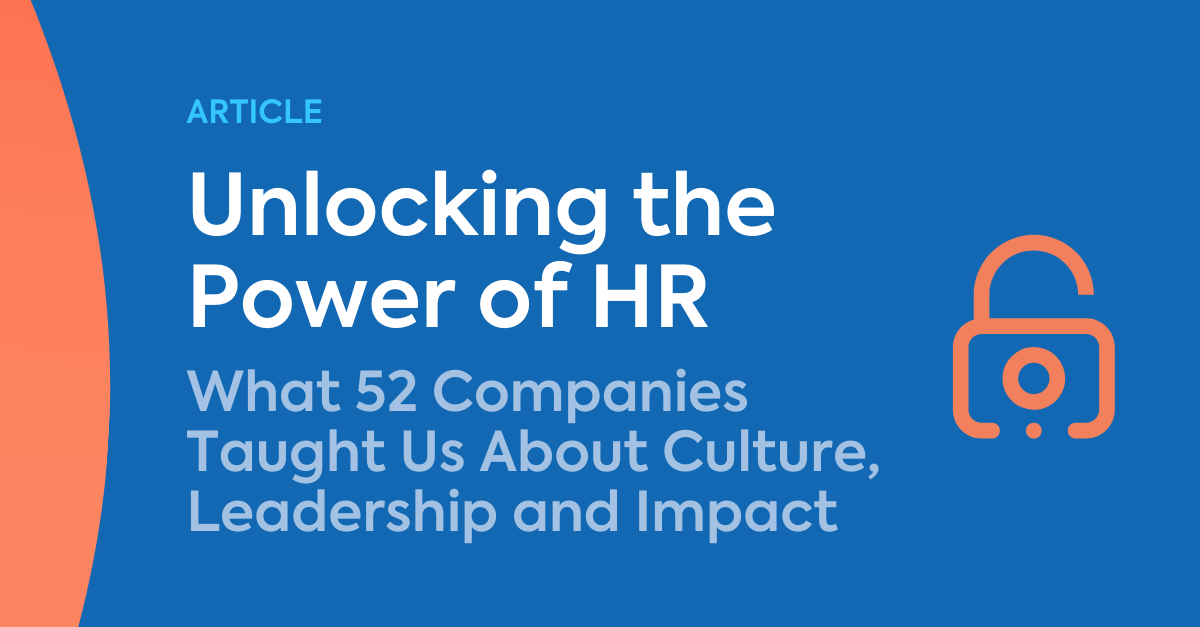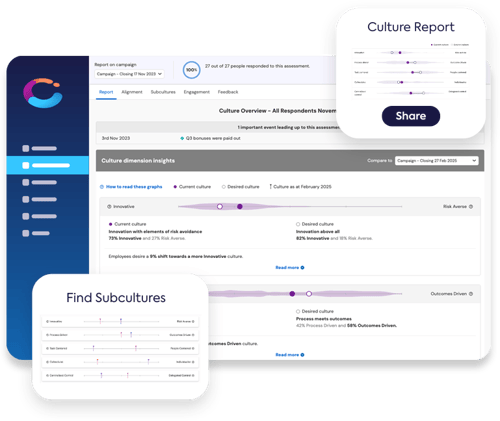8 min read
Unlocking the Power of HR: What 52 Companies Taught Us About Culture, Leadership and Impact
 Rudy Crous
Aug 20, 2025 12:52:00 PM
Rudy Crous
Aug 20, 2025 12:52:00 PM

Table of Contents
A white paper by Compono - August 2025
Why HR Still Feels Stuck and How to Change It
In boardrooms across Australia and New Zealand, something familiar is happening. HR teams are busy, but not always influential. Despite new tools, expanded remits, and growing expectations, many HR leaders still feel like they are fighting uphill battles: for investment, for strategic voice, for recognition.
We wanted to understand why.
So, in 2025, we surveyed 52 companies from nimble startups to enterprise giants across a wide range of industries in ANZ. Our goal was to answer a simple question:
What makes HR truly impactful?
What we found was clear: HR's ability to influence and drive change is not about budget or headcount. It is about how leaders see HR, how culture shapes investment, and where HR chooses to focus its time.
This white paper tells that story with the data to back it up.

The Hidden Driver of HR Power: Leadership Perception
If there is one number to remember from our research, it is this: 45%.
That is how much of HR's focus is explained by leadership perception alone. In other words, when executives see HR as a strategic partner, the function transforms, investing in culture, developing leaders, and improving performance. When they do not, HR gets boxed into admin work, no matter how capable or ambitious the team is.
The Perception Gap in Action
Take two medium-sized companies. On paper, they look similar. But in one, HR has a seat at the leadership table. In the other, HR reports only on policies and compliance. The difference? Perception.
Strategic Implications
To grow HR's impact, the first lever is not budget, it is executive mindset. HR leaders must actively shape how they are seen by speaking the language of business, delivering insights that matter, and tying people strategy to company goals.
Actionable Steps
- Speak the language of business: Link HR initiatives to revenue, cost savings, or risk mitigation.
- Show quick wins: Launch small, high-impact programs like a leadership workshop and share measurable results.
- Educate executives: Present people data that connects directly to business KPIs.
Culture as the Investment Filter
It is easy to assume that companies with bigger budgets invest more in HR. But our data shows something more nuanced: It is not how much money you have, it is what you value.
Culture explains 37% of the difference in HR investment levels.
In people-first cultures, HR is seen as a growth driver. These companies invest in talent tools, employee engagement platforms, and systems that help leaders lead better.
In process-driven cultures, HR is seen as a cost centre. Investment is minimal, often limited to payroll and compliance systems.
This holds true across company sizes. Some large firms still underinvest in HR tech, while some mid-sized firms punch well above their weight. The cultural mindset makes the difference.
Strategic Implications
To unlock investment, HR must frame the case through cultural alignment, not just ROI. Demonstrate how people initiatives reinforce the company's values and strategic direction, not merely its operational processes.
Actionable Steps
- Match your message to culture:
- Process-driven firms → Emphasise efficiency gains and risk reduction.
- People-first firms → Highlight retention improvements, innovation potential, and engagement outcomes.
- Build trust incrementally: Launch low-cost, high-impact initiatives that demonstrate value before requesting larger investments.
The 60-Employee Tipping Point
Small businesses face unique HR challenges. Founders juggle hiring, payroll, and performance conversations all while trying to grow the business.
Our survey revealed:
- 67% of companies under 60 employees had no dedicated HR staff
- Around 60 employees is the tipping point where informal HR breaks down
The Cost of Informal HR
- Informal processes stop scaling
- Leaders spend more time on HR than on strategy
- The "cost of chaos" starts to appear as hiring slows and culture drifts
Strategic Implications
Early-stage companies don't need comprehensive HR departments, but they require systematic approaches and dedicated thinking about people beyond immediate operational demands. Strategic HR investment compounds quickly when implemented at the right growth stage.
Actionable Steps
- Quantify the hidden costs: Track and present leadership hours consumed by HR tasks to demonstrate the true cost of informal processes.
- Implement foundational systems: Establish core processes for onboarding, recruitment, learning management, and policy frameworks.
- Frame HR as growth enablement: Position people systems as infrastructure that frees leadership capacity for revenue-generating activities.
Navigating the Stakeholder Maze
As companies grow, decision-making gets more complex. In small firms, the CEO might approve a new HR tool over lunch. In a large enterprise, that same decision can take months.
Our survey found:
- 68% of medium-sized companies require input from HR, IT, and Finance on people-related investments
- 40% of large companies described their process as involving "extensive consultation" across departments
The result? Even great HR ideas can stall without cross-functional alignment.
Strategic Implications
HR leaders must transform from project owners to coalition architects. Success requires translating HR value into each stakeholder's language: technical feasibility for IT, financial returns for Finance, and risk mitigation for Procurement. Pilot programs provide proof points that reduce organisational resistance to larger investments.
Actionable Steps
- Develop stakeholder-specific value propositions: Present ROI analysis for Finance, technical compatibility assessments for IT, and risk management frameworks for Procurement.
- Leverage pilot programs for credibility: Execute small-scale trials that demonstrate measurable value before pursuing comprehensive initiatives.
- Cultivate internal advocates: Identify and engage influential champions within each department to support your initiatives.
The Integration Challenge: Why Tech Adoption Isn't Enough
There is no shortage of HR systems on the market. But here is the reality:
Only 20% of large companies in our study reported fully integrated HR systems.
Key Finding: Integration rates remain low across all company sizes - small firms achieve just 5% integration, medium firms reach 15%, while large organisations plateau at 20% despite 90% technology adoption rates.
The Integration Gap by Company Size
- Small firms lack infrastructure
- Medium firms face priority overload
- Large firms wrestle with legacy tech and complexity
Without integration, even great tools under-deliver. Data sits in silos. Reports take hours. Employee experience suffers.
Strategic Implications
The competitive advantage lies not in technology acquisition but in data connectivity and system integration. HR leaders who develop expertise in data architecture, systems thinking, and change management become invaluable internal problem-solvers who can bridge the gap between HR needs and technical implementation.
Actionable Steps
- Prioritise integration architecture: Evaluate existing systems and data flows comprehensively before selecting new technology solutions.
- Establish IT partnerships early: Collaborate with IT teams during planning phases to prevent costly implementation delays and compatibility issues.
- Drive user adoption strategically: Integration delivers value only when employees and managers actively utilise the connected systems.
What High-Impact HR Teams Do Differently
So what separates impactful HR teams from those still fighting for relevance?
Our data shows that HR priorities explain 43% of their influence on business strategy. That means what HR chooses to work on matters.
Key Finding: Teams focusing on leadership development and talent strategy achieve significantly higher business influence than those concentrated on compliance and administrative functions.
The Priority Divide
High-impact HR teams focus on:
- Leadership development
- Culture
- Talent strategy
Low-impact HR teams focus on:
- Compliance
- Policy
- Transactional work
Strategic Implications
Organisations recognise teams focused on leadership development, employee experience, and workforce planning as growth catalysts. Conversely, teams concentrated solely on administrative or compliance functions remain positioned as support services rather than strategic contributors.
To expand influence, HR must deliberately select initiatives that directly address core business challenges including retention, performance optimisation, and organisational growth, while establishing measurement frameworks that demonstrate tangible impact.
Actionable Steps
- Select initiatives with measurable business impact: Connect HR projects directly to revenue generation, retention improvements, or risk reduction outcomes.
- Communicate results in business terms: Replace HR-specific terminology with metrics and language that resonate with executive stakeholders.
- Curate a strategic project portfolio: Concentrate efforts on fewer, high-impact initiatives rather than managing numerous low-value administrative tasks.
The Evidence Gap: Where We Align - and What We’ve Uncovered
Novel Contributions
This research fills a critical gap by quantifying dynamics previously understood only anecdotally:
- Culture Focus as an Investment Predictor: We quantify how leadership’s mindset about HR - as strategic or operational - drives investment decisions. Culture (people vs. process) explains more variation in HR tech spend than traditional metrics like budget or headcount.
- Leadership Perception's Strategic Impact: We quantify how business leaders' view of HR determines whether teams work on strategic initiatives or remain confined to administrative tasks.
The Missing Business Perspective on Culture Change: Organisational culture has become a top HR priority in 2025, according to Gartner, alongside leadership development and workforce planning. This shift reflects HR’s growing responsibility for reshaping how organisations engage employees, embed values, and align behaviour across the business. Yet most research focuses only on how HR plans to drive change - not whether it has the organisational support to succeed.
Our data fills this gap. Business leaders’ perception of HR and the importance of having the right work environment, fundamentally determines whether culture initiatives are resourced and prioritised. This credibility assessment explains 45% of the variance in strategic focus - a dynamic never previously measured in organisational change literature. Without that business backing, even the best-designed culture strategies struggle to gain traction.
Where This Diverges from Industry Research
While Compono's findings align with established patterns, our data challenges two prevailing industry narratives:
- Strategic HR transformation follows predictable patterns, not mysterious cultural alchemy. Industry research treats the operational-to-strategic shift as an intangible challenge. Our data shows measurable drivers: leadership perception explains 45% of strategic focus variance, cultural values determine 37% of investment patterns. The transformation isn't mysterious - it's quantifiable.
- The real barrier isn’t just integration - it’s data portability and usability. While many HR systems collect vast amounts of information, only 20% of large firms report having fully integrated platforms. Even then, the challenge goes deeper: disconnected data schemas and incompatible formats mean systems can’t translate or apply insights across the employee lifecycle. As a result, critical information gathered during one stage - like engagement or hiring - often fails to inform decisions in development, retention, or performance. Solving for integration alone isn't enough; the real value lies in ensuring that data remains usable, connected, and insight-driven across every stage of the employee journey.
The reality is more practical and more challenging than market narratives: measurable factors drive transformation success, but operational constraints move slower than industry hype.
Validation of Established Patterns
Our research reinforces several industry observations:
- Company size and HR specialisation correlation remains strong
- Medium and large organisations increasingly position HR as strategic partner
- Global research from Deloitte and McKinsey (2022–2025) on HR's rising influence in larger firms aligns with our ANZ-specific findings
These findings create an evidence-based framework for HR evolution: influence grows where leadership perception shifts, culture drives investment, and priorities align with business outcomes - though this journey remains uneven, particularly for smaller organisations."
Conclusion: The New Rules of HR Impact
HR does not need to wait for a bigger budget or a bigger team to make a difference. The most successful HR leaders focus on four key levers:
- Changing how they are seen - from admin to strategic advisor
- Shaping mindset - influencing how leaders connect culture to investment and decision-making
- Prioritising high-impact work - that directly aligns with business goals
- Navigating complexity - managing multiple stakeholders and systems while turning data into actionable insight across the employee lifecycle
The future of HR is not just digital - it’s strategic, cultural, and deeply human.
And it starts with knowing which levers to pull.
Advice to Executives
While HR can drive meaningful change without major budget increases, they still need to be adequately resourced to operate strategically.
Leaders must shift how they think about HR - from cost centre to catalyst - and ensure teams have the people, tools, and executive backing to deliver on high-impact work.
That’s what moves the business forward.
From advice to action

Talk to a Compono expert.
We’ll have a practical conversation and show how leaders can view - and act on - the right company data for culture, leadership and workforce signals in Compono, using representative examples. You’ll leave with clear next steps to resource HR for impact.
Appendix: Survey Data & Correlation Insights
Survey Methodology
- Sample: 52 ANZ organisations
- Company sizes: Small (<60): 29%, Medium (61-1,000): 42%, Large (1,000+): 29%
- Respondents: HR, SLT, Operations, and Procurement
- Industries: Tech, Manufacturing, Public Health, Transport, and Professional Services
1. HR Staffing by Size
| Company Size | % with No HR Staff | Avg Leadership Time on HR | HR Maturity Level |
|---|---|---|---|
Small |
67% |
6-10+ hrs/week per leader |
Informal, reactive |
Medium |
23% |
3-6 hrs/week per leader |
Transitional, specialising |
Large |
0% |
1-2 hrs/week per leader |
Fully staffed, strategic |
2. Key Correlation Findings
| Relationship | r | R² | Insight |
|---|---|---|---|
Leadership Perception → HR Priorities |
0.67 |
0.45 |
45% of HR's focus is driven by how leaders view it |
HR Priorities → HR Business Influence |
0.66 |
0.43 |
43% of HR's influence comes from its focus |
Culture → HR Tech Investment |
0.61 |
0.37 |
37% of HR tech investment is explained by culture |
3. Technology Adoption & Integration
| Company Size | HR Tech Adoption | Full Integration | Common Challenges |
|---|---|---|---|
Small |
35% |
5% |
No infrastructure |
Medium |
65% |
15% |
Priority conflicts |
Large |
90% |
20% |
Legacy systems & complexity |
4. Decision-Making Complexity
- Medium firms: 68% need HR, IT & Finance sign-off for HR projects
- Large firms: 40% require extensive cross-department consultation
- Avg. approval timeline: 2–3 months for major initiatives
5. References & Sources
McKinsey & Company. (2023). The State of Organizations 2023: Ten shifts that are transforming organizations-and what to do about them. McKinsey & Company.
Link: https://www.mckinsey.com/~/media/mckinsey/business%20functions/people%20and%20organizational%20performance/our%20insights/the%20state%20of%20organizations%202023/the-state-of-organizations-2023.pdf
Deloitte. (2024). HR in the boundaryless organization. Deloitte Insights.
Gartner (2024): "Gartner HR Leaders Survey Reveals Top Two Priorities in 2024 are Leader and Manager Development and Organizational Culture"
Link: https://www.gartner.com/en/newsroom/press-releases/2023-11-07-gartner-hr-leaders-survey-reveals-top-t
Gartner (2024): "Gartner Survey Finds Leader and Manager Development Tops HR Leaders' List of 2025 Priorities for Third Consecutive Year"
Link: https://www.gartner.com/en/newsroom/press-releases/2024-10-15-gartner-survey-finds-leader-and-manager-development-tops-hrleaders-list
Gartner (2025): "Top HR Focus Areas for 2025" - Including leadership development, cultural alignment, and workforce planning”
Link: https://www.gartner.com/en/articles/top-hr-focus-areas-for-2025
Related

Understanding Attrition Rate: A Comprehensive Tutorial for HR Managers
The article provides an in-depth exploration of attrition rates, which measure employee departures as a percentage of the workforce. It underscores...

C-Level Executives: Defining Their Roles and Impact on Business
C-level executives are essential leaders whose roles significantly influence an organisation's direction, operational efficiency, and overall...



.png?width=383&height=200&name=team%20(1).png)


.png)